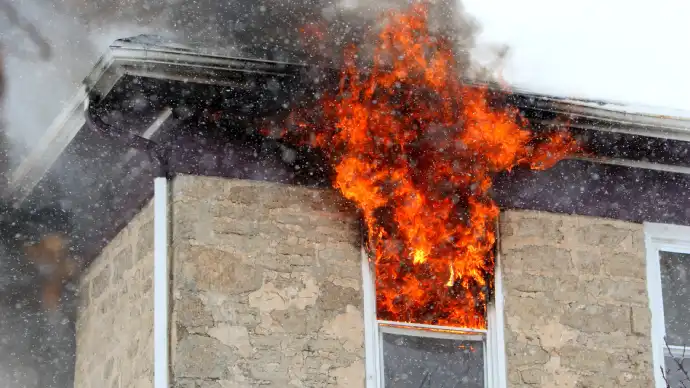Fire is one of the home-affecting disasters that you can prevent from happening. All it takes is thorough preparation to avoid fire accidents at your house. Install these necessary fire-prevention devices and keep your house fire safe.
Fire Extinguishers

They are the most effective tool you can use to lessen the risk of fire accidents at home. However, you must strategically place them in areas visible to the people inside the house to quickly access them when a fire happens.
Fire extinguishers have various classification usages, including combustibles, flammables, and gases. Familiarize their class before buying one for your home.
Class A – ideal for regular combustible materials
Class B – works well with flammable liquids
Class C – ideal for gases such as methane and acetylene
Class D – perfect for combustible metals
Class E – perfect for electrical fires
Class K – ideal for highly flammable cooking liquids
Note: Teach your family when and how to use the fire extinguisher safely. To quickly remember how to use it, explain to them what the abbreviation PASS means.
P – P stands for “pull the pin.”
A – A stands for “aim low.”
S – S for “squeeze the lever.”
S – S stands for “sweeping the nozzle from side to side.”
Smoke Alarms

Fire can spread swiftly and burn down a house in minutes. Prevent it from spreading in less than a minute by installing smoke alarms which lessens the fire risk by around 50%. Smoke alarms can quickly detect smoke which is one of the indicators that there’s fire.
Most houses use smoke alarms with ionization detector that uses radioactive materials to detect smoke, and other uses photoelectric that sees a certain amount of light before it sounds.
Both fire detectors can detect smoke and slow and fast-burning fires. However, you need to check their best-selling features further as each has different advantages and disadvantages, or you may buy both and put them in locations prone to fire.
Fire Exits

There needs to be more than just fire extinguishers and alarms in your house to protect it entirely from fire. It would help if you had at least two fire exits that people inside the house could quickly use to escape and for the firefighters to use to get inside the house, rescue the people trapped inside, and put out the fire.
However, ensure that the fire exits follow OSHA’s rules and regulations. It must be large enough for a grown adult to fit in and lead directly to a safe space outside the house.
Fire-Rated Access Doors

Depending on their fire rating, these access doors can prevent fire spread for up to three hours, allowing you more time to rescue and escape in case of fire emergencies. Although fire-rated access doors are not standard in residential buildings, it is advisable that you must have at least one installed in your house.
Also, you can have a fire-rated access panel for your duct, HVAC system, or both, as they share the same purpose. They not only protect the component but also prevent fire from spreading. Thus, consider installing UL and NFPA-approved fire-rated access doors and panels. With their durable materials, you can protect your house from fire.
Fire-Rated Roof Hatches

Commercial and industrial buildings usually use roof hatches to access their HVAC system to ensure system efficiency. But do you know they function as fire-protection hatches, too?
There are various fire-rated roof hatches, but the most common types are insulated and non-insulated. Both types are efficient in preventing fire spread and letting the heat, smoke, and harmful gases out when a fire happens. They also serve as an escape route for the people trapped inside the house and, simultaneously, an entryway for the fire response team.
Fire-rated roof hatches may be expensive, but they can indeed protect you and your house from damaging fire.
Surge Protectors

Most of the house’s air conditioning units, refrigerators, computers, laptops, cellphones, surround sound, and flat-screen TVs are prone to electric surges that can severely damage the units and fire. Faulty wiring can also lead to an unwanted power spike which might lead to a fire.
Prevent a potential fire accident by using a surge protector for these appliances. It allows you to plug in two or more devices and protects the components from getting power spikes by diverting the electrical current back to the grounding wire.
In some instances, connecting it to a power strip may work perfectly fine, but it is not highly advisable. It is best to avoid connecting it to another power strip that might not be able to handle the voltage. Instead, you can connect the surge protector directly to the power outlet.
Also, avoid using two-year-old surge protectors. It might not show that it does expire, but its lifespan is only around two years. Any power surge that goes past that may already have issues.
Final Thoughts
Preventing a fire is easy. All you need to do is follow all the instructions on how to use the appliances and avoid overloading the circuit to lessen the risk of fire spark. Also, ensure that you are using new and quality appliances at home since you cannot guarantee that the hand-me-down and second-hand appliances are not defective.
Letting your family understand how fireworks and how to prevent them is also a significant factor in keeping your house safe. You can find multiple videos online that follow the NFPA guidelines. You may use these to educate your family, especially children under ten. Knowing the effects of the fire will help them properly use the appliances to prevent and hold the blaze from spreading quickly.
May the list of the most important things you must have to keep your home safe from fire helps you. Remember that the fire extinguishers, fire alarms, fire exits, surge protectors, fire-rated access doors, and roof hatches must follow NFPA’s strict rules and regulations. Otherwise, your house might have a higher risk of getting burned.
